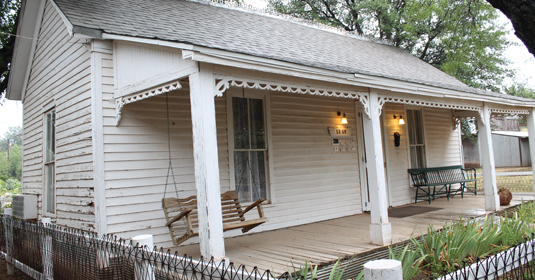The rickety white house has odd angles. 
A doorway slants one way. The ceiling slants another. Yet another doorway sags in its own direction, weary from holding itself up for more than a century.
In a few places, daylight shines straight through.
The house has a musty smell, as if it has bottled up the odor of decades of living and mixed it with decades of vacancy. And moisture.
On this summer West Texas day, a rare rainstorm is overhead, and the silence of Hill house is broken by the tap, tap, tap of water rolling off the roof and onto the peeling white paint below. Inside, wood floors creak unsteadily with each footstep, but the home feels dry and cozy.
Antique beds, tables and chairs fill each room. The kitchen is stocked with period dishes and pots, arranged in a way that looks as though they were abandoned in mid-use many years ago.
In the front parlor, the portrait of a handsome young man hangs prominently against blue wallpaper. The part of his wavy dark hair, the mustache and goatee–all the unmistakable features of Tom Hill, the first city marshal of Abilene.
Tom built this house with his own hands in 1882. This is where he brought his wife, small daughter and infant son to live. And this is where many of their lives ended, one at a time, some quietly, others painfully, over the course of decades.
The Hill family is buried together in the Abilene Municipal Cemetery. But some claim their spirits never left this house.
Today, Hill house is the most popular destination for visitors at the Buffalo Gap Historic Village. Each year, thousands of visitors shuffle through the 20 plus historic buildings gathered at the museum village six miles south of Abilene.
The museum started in 1956 as an Old West museum. The Hill house was added in 1964, and over the years, other historic buildings were, too.
Rowdy Abilene
The Hill house was originally located in downtown Abilene across from St. Paul United Methodist Church.
Tom Hill lived there with his family while he served as Abilene’s first marshal and the city’s tax collector. Abilene was a rough town back then, having been founded in only 1881. The city was a sea of tents and rough buildings occupied by rowdy cowboys.
When the county seat was switched from Buffalo Gap to Abilene after a contentious vote in 1883, Tom provided the extra security needed to move the records to Abilene.
It was also in 1883 that Tom met Mollie Houser, a young woman who had moved along with her mother to Abilene from Waco for her health. Her brother, Terry Houser, later served as Abilene’s fire chief.
Mollie was taken with the man from Kentucky and told friends she’d “set her cap” for the handsome marshal.
The couple wed in Abilene on Oct. 14, 1883, and moved into a house Tom had prepared for her right down to the napkins on the dining table.
Less than a year later, their daughter Belle was born, followed by a son, Terry Clifton Hill, in 1885. Around this time, Tom moved his family to the rental house he had built at 1346 N. 5th St. Tom expanded the rent house, adding a parlor, hallway and other rooms.
Larceny in their hearts
A few months before his son was born, Tom Hill was caught up in a New York City murder that tarnished his image in Abilene and temporarily stopped his career in law enforcement.
A friend of his named Jim Holland received a letter from a New Yorker named Tom Davis offering to sell him $10,000 cash for $500. Davis admitted the money was counterfeit, explaining that an old, discarded federal press was used to make it. He mailed Holland a $5 bill as proof, and an Abilene bank authenticated it.
Holland and Tom Hill decided to go to New York together to make the exchange with Davis. The pair had “larceny in their hearts,” according to the book “Gunfire on South Front: History of the Abilene Police Department 1881-1993.”
It was not Tom’s finest moment, and things were about to go very wrong.
Once the pair got to New York, Holland went to meet Davis while Tom waited outside the building. A scuffle between Holland and Davis broke out after the money exchange. The satchels had been switched, and Holland was left with a bag full of brick and sawdust.
Holland shot Davis dead. Davis’ brother, who had been hiding nearby, jumped out and loudly accused Holland of murder on the streets below.
Holland and Tom were arrested, and the ordeal made headlines in New York and Texas. Holland was eventually charged with murder; Tom was bailed out by Abilene city leaders. He was called to testify as a witness.
At the trial, a New York newspaper described Tom, who was wearing spectacles, as someone with the “appearance of an overworked school teacher.” The unmarried Holland was described as the “traditional Texan of the dime novel of the ‘half man, half horse and half alligator type.’”
A jury acquitted Holland in 15 minutes, apparently accepting his explanation of self defense.
He went foot first
Despite his friend’s exoneration, and the fact that he was not charged with murder, Tom Hill’s career in Abilene was over. He resigned from city marshal sometime in 1886.
During the months that followed, Tom got a new job, this time as deputy sheriff in Runnels County. While his wife and two children stayed in Abilene, he hit the mean streets of Ballinger, also a newly minted town like Abilene bustling with cowboys, desperados and drunks.
On Aug. 6, 1886, an intoxicated saloon owner armed with a Winchester rifle was shooting out street lights. The man was a former deputy sheriff from Maverick County, and it’s possible he and Tom may have been friends.
But on that day, Tom was trying to disarm him because of the disturbance he was causing. Instead, Tom was accidentally shot in the foot. A doctor worked to amputate one of his toes, but he died the next day. The actual cause of death is unknown.
His daughter Belle told the Abilene newspaper in 1943 that her father may have died from lockjaw, an overdose of chloroform or other causes.
Newspapers kept the
cold out
Tom’s loss was devastating for his family, who laid out his body for viewing in the parlor of their Abilene home. Two months later, his 10-month-old son died.
Mollie, Belle and Mollie’s mother Martha Houser Proctor lived on in the house on North 5th Street. For the first few years, the family fared well and newspaper stories chronicled Mollie’s active social life and travels. Later, though, she sold land to provide money for the family.
Martha died in 1900, leaving only Mollie and Belle to inhabit the little wooden house. As the years past, their situation became dire. They tried to make ends meet by selling homemade greeting cards, according to Jaunita Zachry’s book, “Buffalo Gap Historic Village.” City directories and census records also listed Belle’s occupation as real estate sales and bookkeeper.
Their house fell into disrepair. The women spread layers of newspapers over the walls to keep the wind from seeping through the cracks. In the final years, visitors were only allowed in the parlor, the only room they could keep presentable, so that they could sell greeting cards.
Members of St. Paul’s United Methodist Church tried to give the women food, but their pride was too great to accept it. Later, church folks started leaving food on their doorstep without knocking. When they would look back, they would see Mollie and Belle quickly dragging the boxes inside, according to Zachry’s book.
Despite their dire circumstances, the women refused to sell the furnishings or belongings that Tom had bought.
Mollie died in 1952 at the advanced age of 97; Belle followed her in 1960. She left her house to the Methodist Home for Children in Waco. By 1964, the house and its furnishings were moved to Buffalo Gap to join other historic properties in a museum village.
Today, that museum village is known as the Buffalo Gap Historic Village and is home to 20 plus historic buildings, including the original Taylor County Courthouse, built in Buffalo Gap when the town was the first county seat.
Rumors of haunting
Sometime after the Hill house was opened to the public, weird things began to happen.
Dr. Don Frazier, who oversees the foundation that runs the village, told the story of one recent visitor who said he had visited the Hill house 30 years ago and will never forget what he saw. Out of the corner of his eye, he claimed to have seen the half figure of a woman.
Heather Reed, site manager for the museum village, said one night she was locking up the Hill house by herself. She locked the front door, then started walking down the hallway toward the back door. She thought she saw something out of the corner of her eye.
“You don’t know if you’re playing tricks on yourself because you’ve heard the stories,” Reed said.
She was closing up the house because most of the male maintenance workers at the village won’t do it. They tell stories of the gun cabinet slamming shut on its own and how the house is haunted by Tom Hill’s daughter, Belle. According to the workers, Belle doesn’t like men.
But one worker was the object of someone or something’s attention at the house.
Ken Walker, maintenance supervisor, said he found a vintage white, mother-of-pearl button one day sitting noticeably on a black floor mat in the hallway. He stuck it in his pocket and accidentally took it home.
The next morning, he found it under his pillow.
Another time, Walker was on the side porch repairing rafters on the Hill house. He sat his drill down and walked away. No one else was around. When he came back, a vintage pewter button was sitting on the drill.
“That one kind of gives me goosebumps,” Walker said.
In March, the West Texas Paranormal Society based in Lubbock was invited to lead a night of ghost hunting around Buffalo Gap Historic Village. The most memorable experiences that night took place in Hill house.
The ghost hunters told the museum village employees that they picked up on an old woman who did not care for men. Their findings seemed to confirm the stories they had been hearing, Reed said.
More good than ghostly
Reed said she hopes to invite the paranormal society back for more investigations. And the museum village’s annual ghost tours are on tap this October as well.
Not everyone, though, is buying into the ghost business.
Sheila Spencer Lein, of Seattle, Wash., who is related to Belle Hill on the Houser side of the family, said ghosts may be good for tourism, but she doesn’t believe in them.
“The Housers were strong Christians, and the suggestion that Belle›s spirit remains in her home is laughable,” she said in an email.
Lein, whose grandmother Allie Houser Spencer was Belle’s first cousin, was also surprised to hear that the supposed ghost of Belle does not like men and came across as a grumpy old woman.
“No conversation I had with my grandmother ever indicated that Belle Hill was anything other than a very normal, caring person, and certainly nothing was said to indicate eternal unrest!” she said.
Belle and Allie were seven years apart, but they were close. They kept in touch until Belle’s death. Allie talked lovingly of Belle and was proud of Tom Hill’s accomplishments, Lein said.
As a trained historian, Reed said she’s skeptical about hauntings. She doesn’t believe, for example, that Belle Hill will ever float around like a specter in a horror movie. But what visitors might pick up, she added, is a certain energy at Hill house.
Perhaps an unseen force is drawing visitors to the home, driving them to want to know more about the fascinating lives of the Hill family. It could be the strongest force of all – curiosity.



























Leave a Reply